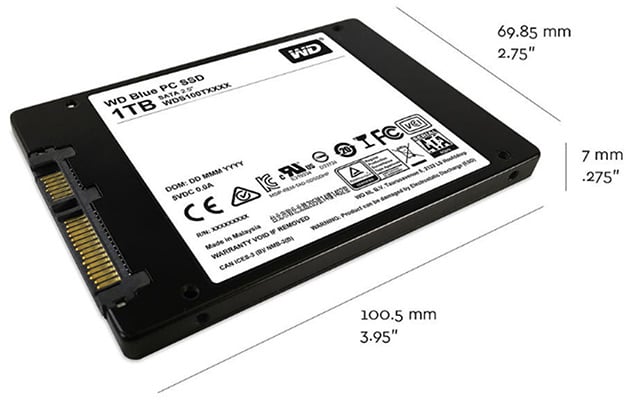WD Blue SSD Review: Aggressively-Priced Solid State Storage
Western Digital is the king of the hard drive market but up to now has been a non-factor in SSDs. However, with its purchase of solid state storage giant, SanDisk, the company immediately leaped to the forefront of the market in one fell swoop.
Now the company is entering the consumer/commercial SSD market with WD Green and WD Blue SSDs, using a naming scheme borrowed from its hard drive line and technology acquired from SanDisk. WD's Green lineup is for entry level PCs meant to have a low power draw while the Blue SSD series is aimed at mainstream consumers. Both series are available in both 2.5″ SATA III and M.2 SATA III form factors.
The WD Green SSD is only available in lower density 120GB and 240GB capacities. The WD Blue comes in 250GB, 500GB and 1TB, which is more in line with what power users might be looking for. It may not have AES 256-bit hardware encryption, but this drive does support DevSLP (Device Sleep). In DevSLP mode, the 1TB SSD has a power draw of between 6.0 and 9.7 mW, compared to 70mW for average active power. So it can get down there into low, low power mode.
All WD Blue SSD products are backed by a 3-year warranty that is specified by a terabytes written (TBW) endurance rating, rather than just a Mean Time Before Failure (MTBF). So technically, if you write too much data to the drive, you could void the time left on the warranty.
|
| Specifications | 1TB | 500GB | 250GB |
| Model Numbers | |||
| WD Blue PC SSD 2.5”/7mm | WDS100T1B0A | WDS500G1B0A | WDS250G1B0A |
| WD Blue PC SSD M.2 2280 | WDS100T1B0B | WDS500G1B0B | WDS250G1B0B |
| Interface | |||
| WD Blue PC SSD 2.5”/7mm | SATA III 6 Gb/s | SATA III 6 Gb/s | SATA III 6 Gb/s |
| WD Blue PC SSD M.2 2280 | SATA III 6 Gb/s | SATA III 6 Gb/s | SATA III 6 Gb/s |
| Performance [4KB QD32] | |||
| Sequential Read up to (MB/s) | 545 | 545 | 540 |
| Sequential Write up to (MB/s) | 525 | 525 | 500 |
| Random Read up to (IOPS) | 100k | 100k | 97k |
| Random Write up to (IOPS) | 80k | 80k | 79k |
| Endurance (TBW) | 400 | 200 | 100 |
| Power | |||
| Avg. Active Power (mW) | 70 | 70 | 70 |
| Max Read Operating (mW) | 2,850 | 2,850 | 2,350 |
| Max Write Operating (mW) | 4,400 | 4,000 | 3,400 |
| Slumber (mW) | 45–52 | 42–46 | 42–45 |
| DEVSLP (mW) | 6.0–9.7 | 6.0–7.7 | 4.9–6.0 |
| Reliability | |||
| MTBF | Up to 1.75M hours | Up to 1.75M hours | Up to 1.75M hours |
| Environmental | |||
| Operating Temperatures | 0°C to 70°C | 0°C to 70°C | 0°C to 70°C |
| Non-operating Temperatures | -55°C to 85°C | -55°C to 85°C | -55°C to 85°C |
| Operating Vibration | 5.0 gRMS, 10–2000 Hz | 5.0 gRMS, 10–2000 Hz | 5.0 gRMS, 10–2000 Hz |
| Non-operating Vibration | 4.9 gRMS, 7–800 Hz | 4.9 gRMS, 7–800 Hz | 4.9 gRMS, 7–800 Hz |
| Shock | 1,500 G @ 0.5 msec half sine | 1,500 G @ 0.5 msec half sine | 1,500 G @ 0.5 msec half sine |
| Certifications | FCC, UL, TUV, KC, BSMI, VCCI | FCC, UL, TUV, KC, BSMI, VCCI | FCC, UL, TUV, KC, BSMI, VCCI |
| Limited Warranty | 3 years | 3 years | 3 years |
| Physical Dimensions | |||
| Size: 2.5”/7mm cased | 7.00mm x 69.85mm x 100.5mm | 7.00mm x 69.85mm x 100.5mm | 7.00mm x 69.85mm x 100.5mm |
| Size: M.2 2280 | 2.38mm x 22.00mm x 80.0mm | 2.23mm x 22.00mm x 80.0mm | 2.23mm x 22.00mm x 80.0mm |
| Weight: 2.5”/7mm cased | 59.7g | 37.4g | 37.4g |
| Weight: M.2 2280 | 7±1g | 7±1g | 7±1g |
The WD Blue's hardware is identical to the SanDisk X400, which is very mature technology. So don't have any concerns about WD's "1.0" product here. All three capacity drives use the Marvell 88SS1074 SSD controller and sixth generation NAND from SanDisk manufactured on a 15nm process they share with Toshiba.
The X400 was meant for the mid-tier, as other SATA SSD vendors tended to go either high-end or low-end and ignored the middle. But for a mid-range product, Blue does pretty well. It peaks at 545 MB/s sequential read and 525 MB/s of sequential write speed, while random performance is around 100,000/80,000 read/write IOPS.
WD offers a SSD Dashboard utility that is basically a clone of the SanDisk SSD Dashboard that's been available since 2014. It allows you to check out the status of the drive, make a bootable USB Flash drive to perform secure erase on the drive for those running Windows 8 or newer, update the firmware of the SSD, and more.
The WD Blue is a pretty bare bones package. You get the drive in a plastic tray. That's it. No software, not even a SATA cable.









